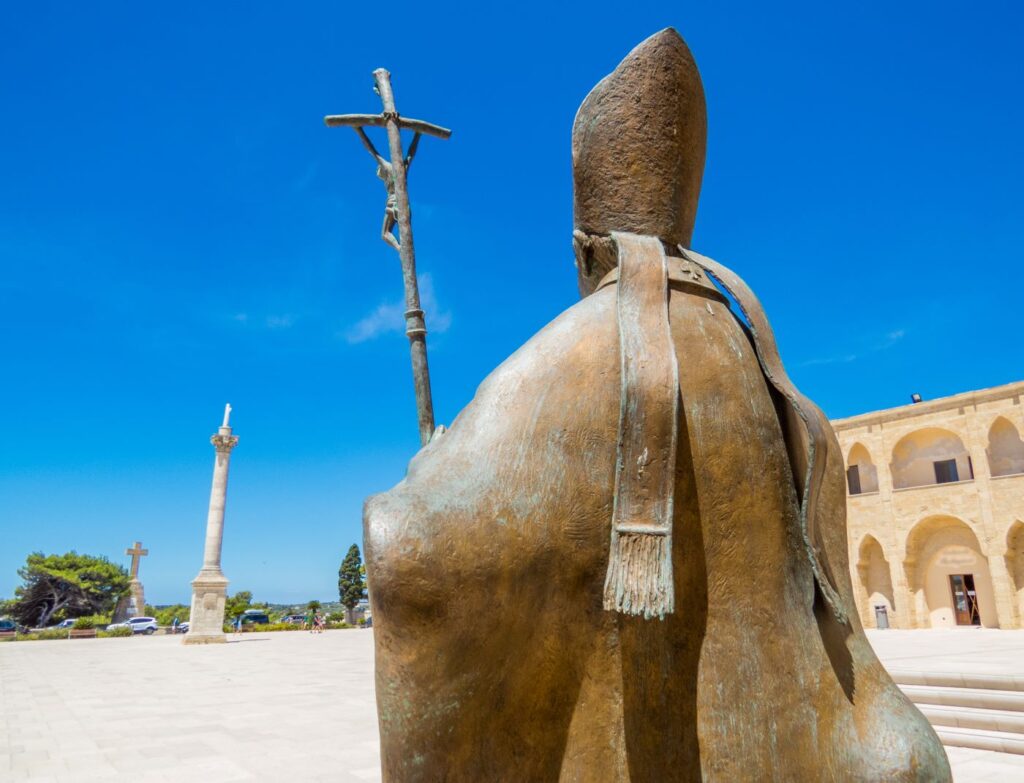Three months after he was elected Pope Benedict XVI, Joseph Ratzinger traveled to Introd, Italy to address some diocesan clergy. His message to the assembled priests was frank and scarcely saccharine. “People seem to have no need of us, everything we do seems pointless,” he said. People, he noted, are not asking the questions for which Christ supplies the answers. The entire West, moreover, “is weary of its own culture.” According to Benedict, “humans [thought they] could build themselves on their own.” Even Christian life, he noted, “becomes a choice that is subjective, arbitrary and no longer the path of life.”
Looking around the globe, Pope Benedict saw that the “sects” attract adherents by offering pat answers to life’s existential questions. Islam flourishes. It is true, Benedict said, that priestly vocations are plentiful in parts of Asia and Africa. But “this joy comes with a certain sadness,” he added, since at least some of them “come in the hope of social advancement. By becoming priests, they become like tribal chiefs, they are naturally privileged, they have a different lifestyle.”
“[T]he Word of God, the kingdom of God,” he went on to say, “seems to have no historical or political importance.”
This sober report was nothing new. The pope recalled that two thousand years earlier “the Lord’s work had begun with great enthusiasm. The sick were visibly cured, everyone listened joyfully to the statement: ‘The kingdom of God is at hand.’” He said, “devils were expelled.” Yet at the same time, “the world stayed as it was. Nothing changed. The Romans still dominated it. Life was difficult every day, despite these signs, these beautiful words.”
Start your day with Public Discourse
Sign up and get our daily essays sent straight to your inbox.The pontiff offered no easy answers to these problems. “The Pope is not an oracle, he is infallible on the rarest of occasions.” Thus, he said, “I share with you these questions . . . I also suffer.”
Benedict took as his text that summer day the Parable of the Sower. With this story, the Lord is saying that “[w]e are living in the period of the sowing, the Word of God seems but a word, almost nothing. But take heart, this Word carries life within it! And it bears fruit!”
Benedict consoled and encouraged his priests: “[w]e must go on, we must go through this tunnel, this underpass, patiently, in the certainty that Christ is the answer and that in the end, his light will appear once more.”
The world is wearier than it was in 2005. The West’s subjectivism has ripened into solipsism. The sects and the imams continue to thrive. The Word of God is whispered.
Pope Benedict’s counsel is thus timelier now than ever.
It is thus providential that St. Augustine’s Press (based in South Bend, Indiana) has just published Daniel Gallagher’s English translation of Who Believes Is Not Alone: My Life Beside Benedict XVI. In it, Archbishop Georg Gänswein (with assistance from Saverio Gaeta) chronicles his twenty years with Joseph Ratzinger/Pope Benedict. Gänswein became personal secretary to the Cardinal Prefect of the Congregation for the Doctrine of the Faith (CDF) on March 1, 2003. He stayed in that role through Ratzinger’s papacy, and on until the pope emeritus died last New Year’s Eve.
Who Believes is an invaluable read for four distinct reasons. Or, rather, the book succeeds admirably on four separate levels. Here they are, in ascending order of importance.
The world is wearier than it was in 2005. The West’s subjectivism has ripened into solipsism. The sects and the imams continue to thrive. The Word of God is whispered.
Level One: An Inside View of Three Popes
Because he also served as Prefect of the Pontifical Household for Pope Francis, Gänswein writes that he had the “opportunity to take part in every important ecclesial event over the last two decades.” Who Believes is the consummate insider’s account of parts of two papacies and the entirety of another.
Among the great “ecclesial events” Gänswein reports are two papal conclaves, including the one that elected a surprised Joseph Ratzinger. Gänswein amply shows that Ratzinger neither expected nor wanted to be pope. He also relates Benedict’s unblinking assessment of how grace operates in that arena: “There are plenty of examples of popes who in hindsight were probably not the Holy Spirit’s first choice.”
Gänswein also carefully describes the popes’ (mostly Francis’s) efforts to clean up the Vatican’s corrupt finances, as well as their (mostly Ratzinger’s/Benedict’s) firm handling of clerical sex abuse cases. Gänswein: “The horrible issue of clerical sexual abuse reached its highest critical point during the years Ratzinger was prefect and pope. In both roles he fought this plague with all his might.”
Level Two: The Prefect and the Pope
Although an intimate eyewitness to their relationship for just a couple of years, Gänswein is privy to Ratzinger’s recollections of his (the Cardinal Prefect’s) epochal collaboration with Pope Saint John Paul II. Gänswein relates in detail their collaboration on the two great encyclicals on morality (Veritatis Splendor and Evangelium Vitae) as well as on the encyclical on faith and reason, Fides et Ratio. He describes Ratzinger as “the orchestral director behind them” all.
Gänswein highlights two other documents prepared by the CDF at Ratzinger’s direction and signed by Pope John Paul II. They are Dominus Iesus (2000), on the unicity of salvation through Jesus Christ, and the 2002 “Doctrinal Note on Some Questions Regarding the Participation of Catholics in Political Life.” The key proposition:
It is a question of the lay Catholic’s duty to be morally coherent, found within one’s conscience, which is one and indivisible. There cannot be two parallel lives in their existence: on the one hand, the so-called “spiritual life” with its values and demands; and on the other, the so-called “secular” life, that is, life in the family, at work, in social responsibilities, in the responsibilities of public life and in culture.
Gänswein devotes an entire chapter to the friendship of the two great men, a bond (he writes) between two “personalists.” He adds that this personalism was “initially received and developed through different channels”: for Wojtyła in confrontation with Soviet domination of Poland, and for Ratzinger in his journey through twentieth-century Catholic thought. Gänswein tells how in season and out of season, Joseph Ratzinger wanted most of all to be a scholar. Several times, Ratzinger sought to take leave of service to John Paul II, expressing his deep desire to return to his study and write books. At each turn, the pope explained his further need for Ratzinger’s help, and there was an end to it.
Even so, Pope Benedict said in 2015: “My spiritual and intellectual journey would have been unimaginable without” John Paul II.
Level Three: Clarifying Misunderstandings
Gänswein writes in the Prologue that “[t]hese pages . . . present a first-hand account that attempts to shed light on misunderstood aspects of [Benedict’s] pontificate,” and, in fact, beyond (emphasis added). Gänswein candidly describes, for example, his own unwitting instrumental role in the 2012 “Vatileaks” disgrace, whereby another member of Benedict’s household stole and released a trove of internal documents, which one American news outlet said (without much exaggeration) “revealed the Holy See to be an unholy nest of conspiracies, backstabbing, and ambition.” (Gänswein reports that Benedict was “heartbroken.”)
Gänswein’s chapter on Benedict’s resignation is an essential guide to an event often mistakenly described, sometimes unintentionally. The chapter on the relationship between Francis and Benedict includes the author’s candid recounting of being abruptly sidelined by Francis and his aides.
“Cardinal Sarah’s Bungled Book” is the heading of Gänswein’s lengthy account (in the words of a January 2020 French newspaper story that Gänswein quotes) of a new book that Cardinal Robert Sarah “co-authored” with the retired pope in “which the two prelates express the same vision of the Church and an identical aversion to polemics.”
The book was rightly taken as a criticism of Francis’s ecclesial style, his ecclesiology, and his evident willingness (confirmed in the present Synod on Synodality) to reconsider the celibate priesthood and Church governance generally. The book includes an essay on the priesthood composed by Benedict, which he had shared with Sarah knowing (in a sense left fuzzy by Gänswein) that Sarah was preparing something for publication.
Gänswein argues that Cardinal Sarah nonetheless overstated Benedict’s contribution to the book and, therefore, the pope emeritus’s willingness to publicly criticize his successor. He recalls the intricate negotiations among Sarah, Francis’s men, and Benedict leading to a “conciliatory statement released to the press, emphasizing that the Introduction and Conclusion were written by Cardinal Robert Sarah, and they were read and shared by the Pope Emeritus.” Gänswein adds, in a rare, sharp observation: “This was simply to say that Benedict XVI had not expressed objections to Sarah’s text, mostly because the contents were not particularly original or innovative.”
Gänswein offers a “personal testimony of the grandeur of a humble man, a superb scholar, a cardinal, and a pope, who helped shape the history of the world today and who will be remembered as a beacon of theological acumen, doctrinal clarity, and prophetic wisdom.” Ratzinger was all of these things. But he was first and always a servant of the Lord, of His Church, and thus of the truth. For that reason, he is a model for every Christian.
Level Four: A Model of Dedication
Gänswein offers a “personal testimony of the grandeur of a humble man, a superb scholar, a cardinal, and a pope, who helped shape the history of the world today and who will be remembered as a beacon of theological acumen, doctrinal clarity, and prophetic wisdom.” Ratzinger was all of these things. But he was first and always a servant of the Lord, of His Church, and thus of the truth. For that reason, he is a model for every Christian.
The suggestion that such a man could be a model for us all seems improbable. After all, Ratzinger’s biography is singular. He served as a teenage soldier in Hitler’s Wehrmacht. Then he ascended to the heights of the academy and the Church. He was unsurpassably brilliant, one of the truly great twentieth-century Christian theologians. He was celibate, and never even an uncle. How could his life be a model for anyone else’s?
Gänswein supplies the answer: Ratzinger was, above all, dedicated to discovering and living his personal vocation, the unique mission entrusted to him by Jesus. In this, he was like everyone else. His “greatest legacy and gift to the Church” “is the Christocentric witness he bears as a believer, in everything he said and did.” In 1977, Ratzinger said that a “bishop acts not in his own name, but as a fiduciary of Jesus Christ and the Church. He is not a manager or a boss, but a steward on behalf of someone else . . . He will be judged precisely on this fidelity: fidelity is his very duty.” The words of St. Francis de Sales “easily describe” Ratzinger, Gänswein says. Ratzinger wrote his friend Esther Betz in 1997 that “I never plan for anything (I never really have). I rather allow myself to be carried along by divine Providence, which has never been harsh with me, even though it has taken me places I never would have imagined.”
Gänswein writes of Spe salvi that it is the “encyclical I would want to have with me if I were shipwrecked on a deserted island. Every time I reread it and reflect on it, I discover new details that respond to the most basic existential questions of every man and woman alive today.”
Joseph Ratzinger looked at reality straight on, without blinders, neither a pessimist nor an optimist; with trepidation but always with Christian hope. He persevered, trusting in the promises of Christ as we must. He did so as almost all of us have to, without benefit of any special grace. Gänswein reports that Joseph Ratzinger never had a special private revelation on any matter whatsoever.
Image by Diego Fiore and licensed via Adobe Stock. Image resized.














